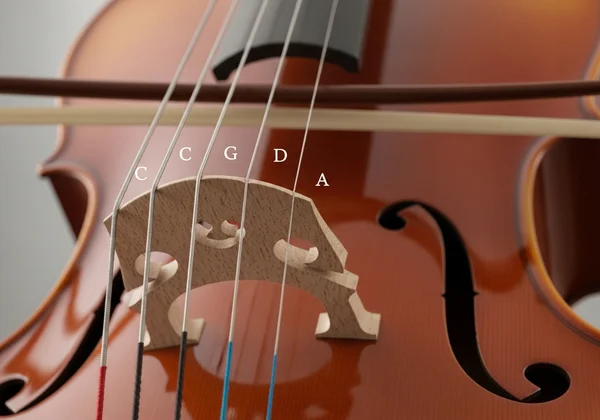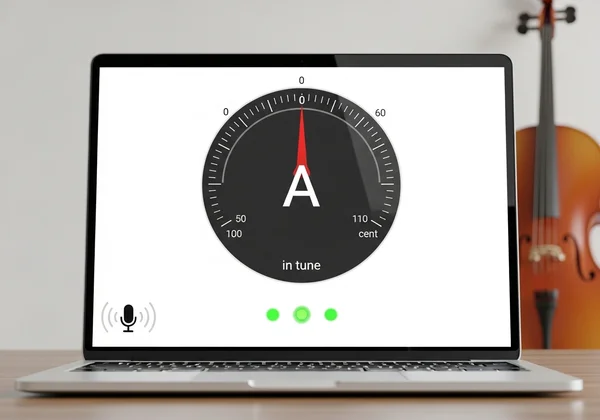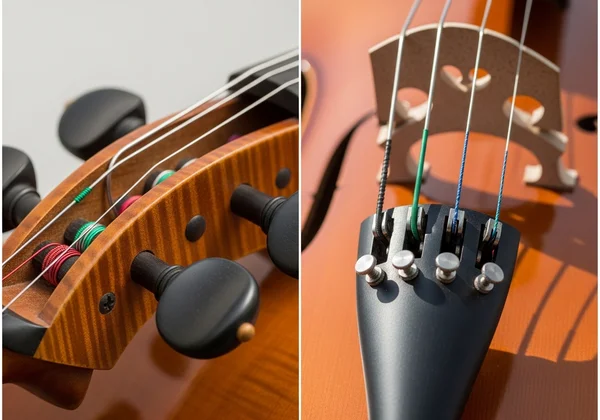Tune Your Cello: A Beginner's Guide with an Online Tuner
Embarking on your cello journey? The first step is crucial: tuning. Before you can play your first piece, getting your instrument to the perfect pitch is essential. For many beginners, tuning can feel intimidating. You might be wondering, how to tune a cello online? This guide is here to show you that with a reliable cello tuner, the process is simple, quick, and accurate. We'll walk you through every step, turning a potentially tricky task into a confident habit. With the right guidance and a great online tuner, you'll achieve perfect pitch and unlock your cello's true voice.
Understanding Cello Standard Tuning: CGDA Notes
Before you touch a single peg, it's essential to know what you're aiming for. The standard tuning for a full-size, four-string cello is CGDA. This sequence of notes forms the foundation of every scale, melody, and harmony you'll learn to play. Understanding these notes is your first step toward musical independence.
The Four Strings of Your Cello: C, G, D, A
Your cello has four strings, each tuned to a specific pitch. Let’s identify them, starting from the thickest, lowest-sounding string to the thinnest, highest-sounding one:
- The C String: This is the thickest string, located furthest to your right as you sit with the instrument. It produces the lowest note.
- The G String: Moving inward, the next string is the G string.
- The D String: The third string is the D string.
- The A String: The thinnest and highest-pitched string, furthest to your left, is the A string. This is your most important reference string.
Memorizing this order—C, G, D, A—is fundamental. It's the musical alphabet of your instrument, and knowing it will make the tuning process with an instrument tuner much more intuitive.

Why Accurate Cello Tuning Matters for Beginners
Why is precise tuning so important, especially when you're just starting? Firstly, it trains your ear. Playing an in-tune instrument helps you recognize correct pitches, a vital skill for any musician. An out-of-tune cello can hinder your progress and make even correctly played notes sound wrong.
Secondly, if you ever play with others—a teacher, an ensemble, or an orchestra—being in tune is non-negotiable. It's the basis of creating harmonious music together. Starting with good tuning habits from day one sets you up for success and ensures your practice time is as productive and enjoyable as possible.
Getting Ready to Tune: Essential Tools & Cello Anatomy
Now that you understand the "what" and "why," let's gather our tools and get familiar with the parts of the cello you'll be using. You don't need much, but having the right tool makes all the difference. The primary tool you’ll need is a reliable tuner, and thankfully, you already have access to one of the best.
Choosing Your Tuner: The Benefits of an Online Cello Tuner
While you can buy physical clip-on tuners or download apps, an online cello tuner offers unmatched convenience for beginners. There's nothing to buy, install, or potentially lose. A high-quality tool like the free and accurate tuner on our homepage works directly in your browser.
The benefits are clear:
-
Accessibility: Use it on any device with a microphone—a laptop, tablet, or phone.
-
Simplicity: The visual interface is large, clear, and easy to read, perfect for those who can't yet tune by ear.
-
Accuracy: A good online chromatic tuner is highly precise, detecting the slightest variations in pitch.
-
Cost-Effective: It's completely free, which is ideal for students and parents managing the costs of a new instrument.

Identifying Your Cello's Tuning Pegs & Fine Tuners
Your cello has two sets of mechanisms for adjusting string pitch. It’s crucial to know which one to use and when.
-
Tuning Pegs: These are the large wooden knobs located in the pegbox at the top of the cello's neck. They make significant, coarse adjustments to the string's tension. When a string is very flat (too low), you'll use these pegs. Turn them slowly and carefully, as a small turn can cause a big change in pitch.
-
Fine Tuners: These are the small metal screws located on the tailpiece, down where the strings are anchored near the bottom of the cello. They make very small, precise adjustments. Once you get the pitch close with the main pegs, you'll use the microphone tuner and these fine tuners to dial it in perfectly. Most beginner cellos have fine tuners on all four strings

Step-by-Step Guide: How to Tune a Cello with Our Online Tuner
You're ready! Let’s tune your cello together. This process should be done every time you practice to ensure you're always playing with the best possible sound. Follow these steps carefully, and you'll be in tune in just a few minutes.

Preparing Your Cello and Tuning Environment
Find a quiet room where your device's microphone can clearly pick up the sound of your cello without background noise. Sit comfortably with your cello in the playing position, resting between your knees with the endpin securely on the floor. Make sure you can easily reach both the pegs and the fine tuners while holding the instrument steady.
Connecting to Our Online Cello Tuner
Open your web browser and navigate to Tuner.wiki. The website will ask for permission to use your microphone; click "Allow." The chromatic tuner will appear on your screen, ready to listen. Place your device nearby so its microphone can easily hear your cello. The tuner will display the note you play and indicate whether it's flat (too low), sharp (too high), or perfectly in tune.
Tuning the A String First (Your Reference Pitch)
In orchestral music, the A string is always tuned first. It serves as the reference pitch for the rest of the instrument and the entire orchestra.
- Gently pluck the A string (the thinnest one) with your thumb or use your bow for a sustained sound.
- Look at the online tuner. It will display the note it hears.
- If the note is close to A but the indicator shows it's flat (♭), gently turn the A string's fine tuner clockwise to raise the pitch. If it's sharp (♯), turn the fine tuner counter-clockwise to lower it.
- If the string is very out of tune, you'll need to use the large tuning peg. Be careful! Loosen the string slightly before tightening it to avoid snapping it.
- Continue plucking and adjusting until the tuner's needle is centered and indicates the note A is perfectly in tune.
Tuning D, G, and C Strings Using Relative Pitch & Tuner Feedback
Once your A string is perfect, move on to the D string, then the G, and finally the C. The process is the same for each string. Pluck or bow the string, check the visual feedback on the online instrument tuner, and make small adjustments with the fine tuners.
For the D, G, and C strings, use the large pegs for big adjustments and the fine tuners for precision. Always aim for the needle to be perfectly centered on the tuner's display. Take your time with each string; there is no need to rush.
Mastering Fine Adjustments with the Fine Tuners
The fine tuners are your best friend for achieving perfect intonation. They allow for the tiny adjustments needed to get the pitch just right without the risk of breaking a string that comes with over-tightening the main pegs. Get into the habit of using them for your daily tuning routine. If a fine tuner becomes screwed in too tightly or is completely loose, you will need to reset it by loosening the string with the peg, unscrewing the fine tuner to a middle position, and retuning the string with the peg first.
Common Cello Tuning Challenges & Troubleshooting Tips
Even with the best tools, you might run into a few common issues. Don't worry—they are all fixable. Knowing how to troubleshoot these problems is part of learning the instrument.
Dealing with Slipping Pegs and String Breakage Prevention
One of the most common frustrations is a tuning peg that won't stay in place. As you tighten it, it slips back, causing the string to go flat again. This often happens due to changes in humidity. The solution is to gently push the peg inward toward the pegbox as you turn it. This small amount of pressure helps it grip the wood and hold its position.
To prevent strings from breaking, always make adjustments with the pegs slowly and smoothly. Never force a peg that feels stuck. If you're raising the pitch, tune up to the note slowly rather than going past it and tuning down.
How Often Should You Tune Your Cello?
You should tune your cello every single time you sit down to play. Temperature, humidity, and playing itself can all cause the strings to go slightly out of tune. Taking two minutes to tune before each practice session ensures your instrument sounds its best and reinforces your ear training. A quick check with our free online tuner makes this an easy and essential part of your routine.
Your Tuned Cello Awaits: Practice Makes Perfect!
You've successfully tuned your cello! This essential first step, now a manageable skill, ensures every note you play rings true. Make daily tuning a habit—it's quick, easy, and vital for great sound. Ready to practice? Visit Tuner.wiki now and start playing with confidence and passion!
Frequently Asked Questions About Cello Tuning
Is an online cello tuner accurate enough for beginners?
Absolutely. Modern online tuners that use your device's microphone are incredibly accurate and sensitive. For a beginner, the clear visual feedback they provide is often more helpful than a physical tuner with a small screen. They are more than precise enough for practice, lessons, and even ensemble rehearsals.
What is the standard tuning for a 4-string cello?
The standard tuning for a 4-string cello, from lowest to highest pitch, is C-G-D-A. The C is the thickest string, and the A is the thinnest. This is the tuning used in virtually all classical and contemporary cello music.
Can I tune my cello with just my phone?
Yes, you can! Any device with a modern web browser and a microphone, including your phone, can access our powerful online tuning tool. You don't need to download a separate app. Just open the website, allow microphone access, and you have a powerful cello tuner ready to go.
How often should a beginner tune their cello?
A beginner should check their cello's tuning every time they play. Cellos are sensitive to environmental changes, and even a short practice session can affect the tuning. Making it the first step of every practice session is a fantastic habit to build.